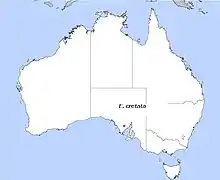Eucalyptus cretata
Eucalyptus cretata, commonly known as Darke Peak mallee[3] or chalky mallee,[4] is a species of mallee or, rarely, a small, straggly tree and is endemic to a restricted part of South Australia. It has smooth whitish and grey bark, lance-shaped adult leaves, glaucous flower buds in groups of seven, white flowers and cup-shaped to barrel-shaped or conical fruit.
| Darke Peak mallee | |
|---|---|
 | |
| Eucalyptus cretata seedling in Maranoa Gardens | |
| Scientific classification | |
| Kingdom: | Plantae |
| Clade: | Tracheophytes |
| Clade: | Angiosperms |
| Clade: | Eudicots |
| Clade: | Rosids |
| Order: | Myrtales |
| Family: | Myrtaceae |
| Genus: | Eucalyptus |
| Species: | E. cretata |
| Binomial name | |
| Eucalyptus cretata | |
 | |
| E. cretata, field distribution | |
Description
Eucalyptus cretata is a mallee, sometimes a straggly tree, that typically grows to a height of about 4 m (13 ft) and forms a lignotuber. The bark is smooth, grey over coppery underbark, shedding in ribbons, and the branchlets are shiny red or brownish green and glaucous. Young plants and coppice regrowth have glaucous, egg-shaped to broadly lance-shaped leaves that are 45–100 mm (1.8–3.9 in) long and 25–50 mm (0.98–1.97 in) wide. Adult leaves are lance-shaped, the same colour on both sides, 78–150 mm (3.1–5.9 in) long and 13–35 mm (0.51–1.38 in) wide on a petiole 12–28 mm (0.47–1.10 in) long. The flower buds are arranged in groups of seven in leaf axils on a peduncle 5–15 mm (0.20–0.59 in) long, the individual buds on a pedicel up to 4 mm (0.16 in) long. Mature buds are glaucous, cylindrical to oval, 8–14 mm (0.31–0.55 in) long and 4–8 mm (0.16–0.31 in) wide with a striated, conical to rounded operculum. Flowering occurs spasmodically and the flowers are white. The fruit is a woody, cup-shaped to barrel-shaped or conical capsule 6–10 mm (0.24–0.39 in) long and 7–11 mm (0.28–0.43 in) wide, often glaucous at first, and with the valves at the level of the rim.[3][5][4][6][7]
Taxonomy and naming
Eucalyptus cretata was first formally described in 1990 by Peter Lang and Ian Brooker from a specimen collected by Lang near Darke Peak in 1989. The description was published in the Journal of the Adelaide Botanic Gardens.[8] The specific epithet (cretata) is a Latin word meaning "marked with chalk",[9] referring to the chalky bloom on the branchlets and flower buds.[5]
Distribution and habitat
Darke Peak mallee grow in mallee communities on the central Eyre Peninsula, between Caralue Bluff Conservation Park, Lock and Cowell.[6]
References
- Fensham, R.; Laffineur, B.; Collingwood, T. (2019). "Eucalyptus cretata". IUCN Red List of Threatened Species. 2019: e.T133375148A133375150. doi:10.2305/IUCN.UK.2019-3.RLTS.T133375148A133375150.en. Retrieved 12 June 2023.
- "Eucalyptus cretata". Australian Plant Census. Retrieved 17 May 2019.
- "Eucalyptus cretata". Euclid: Centre for Australian National Biodiversity Research. Retrieved 4 June 2020.
- "Eucalyptus cretata (Myrtaceae) Chalky Mallee". Seeds of South Australia. Retrieved 17 May 2019.
- Lang, Peter J.; Brooker, M. Ian (1990). "Two new mallee species from South Australia in Eucalyptus L'Herit. series Rufispermae" (PDF). Journal of the Adelaide Botanic Gardens. 13: 71–77. Retrieved 17 May 2019.
- Nicolle, Dean (2013). Native Eucalypts of South Australia. Adelaide: Dean Nicolle. pp. 138–139. ISBN 9780646904108.
- Brooker, I. & Kleinig, D., Eucalyptus, An illustrated guide to identification, Reed Books, Melbourne, 1996
- "Eucalyptus cretata". APNI. Retrieved 17 May 2019.
- Brown, Roland Wilbur (1956). The Composition of Scientific Words. Washington, D.C.: Smithsonian Institution Press. p. 484.
